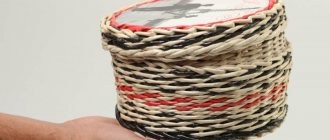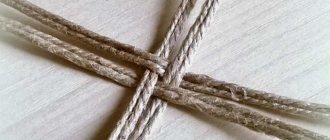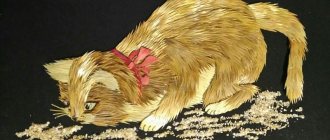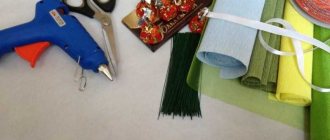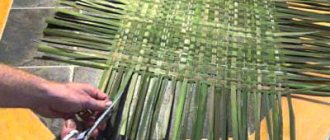At all times, not excluding modern times, one of the most popular items among jewelry was the chain. Almost every person has it and more than one copy. Jewelry is made in various ways, both manually and on a machine. In this article we will look at how to weave a chain with your own hands and what types are feasible for a novice craftsman.
Diamond shape
The armored type of weaving has polished links located in the same plane. Interlocking loops have a rhombic shape and can be connected with one, two or even three links at a time. There are various combinations of armor weave. For example, small links are woven into large ones or sequentially alternate with each other. The first species is called "Nonna", the second - "Figaro". Another weaving method, which can have a square, oval or round cross-section, is called “Snake” or “Cobra”. Indeed, the cord in appearance resembles a snake’s shell and is slightly curved. Rope chain weaving also belongs to the armored type. When connecting the links, the chain rotates slightly in a certain direction, resembling a rope in appearance.
History of chain and chain fashion
The chain rampage proclaimed today by designers did not happen suddenly. Chains have been present in women's and men's jewelry, if not always, then since the beginning of human processing of metal. More precisely, initially the chain was not a decoration, but a clever way to add plasticity and flexibility to the most durable of natural materials.
Nowadays there are soft synthetic fibers, the strength of which is not inferior to metal. And once upon a time, the only thing stronger than metal was stone. But stone, unlike metal, is completely devoid of malleability (the ability to deform). That is, it was unthinkable to obtain fabric or rope from stone with the technology of that time. But it turned out to be possible to connect metal elements to each other without adhesive or cementing compounds. One only through the embrace of one firmament by another. This made it possible to twist ropes from unruly metal.
It is extremely inconvenient to handle it, which stiffens without titanic efforts. But if you divide it into small fragments. Yes, bend them, heated in a forge, into rings. Yes, thread these rings one into the other, firmly fusing the joints in each... And so a chain ended up in the hands of a man, possessing the pliability of a rope and the strength of metal at the same time.
“Chain,” by the way, is the Russian name for the invention. The word owes its etymology to the very process of joining malleable elements. In Proto-Slavic languages it was denoted by the verb “chepit”. Later, along with the sound “ts”, which came into the language of our ancestors from neighboring linguistic cultures, the so-called “tsoking” also came. The original “chain” has become a familiar “chain” to our modern Russian ears.
As for the importance of the invention itself, it cannot be overestimated. Noted by someone observant, the ability of metal to adhere has become the greatest boon for humanity. The coupling gave especially durable clothing to the warriors: chain mail, for example, was assembled from the same interlocking metal ring links. And especially strong bonds are needed in peaceful everyday life.
One of the simplest chain weaves is called anchor. And not by chance. After all, if you can hang a heavy anchor, without which not a single ship can survive, on a rope, it won’t be for long. Metal is more resistant to abrasion and the adverse effects of water, air and sun. So, one of the first widely used chains were anchor chains.
How did the chain fashion, which has lasted for centuries, emerge from practical necessity? Have you ever seen a heavy chain unwind under the weight of an anchor? First of all, it's beautiful! Fashion does not leave anything that is beautiful without attention. Secondly, chain weaving, like any work with metal, required skills and abilities from the very beginning. Where to look for them, if not from skilled craftsmen? And what skilled craftsman would be content with routine, automated work? Even in forging ordinary nails, craftsmen strive to compete for the title of the best. What can we say about chains? Improving the strength of chains, craftsmen improved their appearance, inventing new methods and types of weaving. In general, it’s not so far from work on improving anchor chains to jewelry work.
Thanks to the efforts of jewelers, by the middle of the 7th century the fashion for chains became universal. The nobility, of course, strove to hang a pocket chronometer or theater binoculars on a chain of precious metals. The poor imitated the nobility by wearing chains made of inexpensive alloys that imitated gold or silver. With the advent of complex weaving, the chain has completely ceased to be just a holder for functional personal accessories or a way to hang pendants.
Even now, new ways of weaving chains do not dry out. How the inspiration of fashion designers never runs out, year after year finding applications for chains in their collections.
sea anchor
With the anchor method, the connected links interlock with each other at an angle of 90 0. The loops of a classic chain are oval shaped. This is the simplest weaving method that you can use to make a chain with your own hands. If there is a crossbar between the links, then the weaving is called “Sea Anchor”. There is a coupling of not only narrow, but also wide rings - rollo or chopard. Venetian weaving differs from classical weaving by links that can take the shape of a square or rectangle. One block can contain several elements.
Recommendations
To weave a wire chain, you can use one of the traditional twisting techniques. For example, this could be an anchor method, which requires connecting the links to each other at an angle of 90 degrees. In this case, individual links should have an oval shape. If a crossbar is added between the individual links, the weaving can be called a “sea anchor.”
For information on the Viking weaving technique for creating a chain of wire with your own hands, see below.
Source
Weaving method "link to link"
To make a chain with your own hands using this method, you need to prepare links of the desired shape. The main parameter for any weaving is the correspondence of the diameters of the rings and the wire. The thinner the material and the wider the link, the more unreliable the chain becomes. The opposite option creates difficulties in weaving. The rings are made by wrapping wire around the bolt, so it shouldn't be too small either.
The loops threaded alternately into each other should have the same direction. You can solder the ends of the loops both during weaving and after it. When heated, the melting metal should fill the gap at the bite site. In this way, a possible chain break will be eliminated and the rings will be continuous.
Weaving a double diamond chain
This type of clutch has flat loops shaped like a diamond or an elongated square. Weaving is considered quite durable and popular. The links can be connected one by one, or in groups of two or three pieces together. Women's chains, as a rule, have a flat shape. Men, in turn, prefer massive products with double or triple weave.
The prepared links are stretched, bent and compressed to achieve the required shape. Then weave a chain by inserting the next loop into the previous one. There is a hitch option in which the third link is threaded into the first and passed through the second, then the fourth is threaded into the second and pulled through the third, and so on. After soldering the loops, the finished chain is flattened using rollers. At the end of the work, the hand-woven chain must be polished.
Instructions for making a knife from a chain
In the package version of making a knife from a chain, the product is suitable for various mechanisms: a motorcycle, a car, a bicycle or a chainsaw.
Materials and tools
Having decided on the manufacturing method, you need to prepare the tools and materials:
- an anvil, two hammers - large and small;
- oven or forge;
- vices, angle grinders with discs for various purposes;
Knife from a chain.
tetraboric acid (borax);- Hydraulic Press;
- grinding machine;
- welding machine, steel chain;
- high carbon steel plate;
- motor oil and a container of water;
- drill, wooden block, epoxy glue;
- masking tape, sandpaper of different grains;
- Handle impregnation made from natural oils.
Tools and materials are professional in nature. From the very beginning it was stated that this was a job for experienced craftsmen. Beginners should not try this material. You need to start experimenting with simple preparations.
Forging blanks
A distinctive feature of the batch forging process is the work with several metal plates. Having everything you need, you need to start the initial forging of the blade:
- Using a cutting wheel on an angle grinder, cut the chain into several pieces of equal length. Having folded them into a single form, using welding, we “grab” them to obtain a solid workpiece.
- A rod is welded to the resulting rectangle for ease of holding. Having warmed up the oven, place the workpiece in it and heat it to 1100-1200 °C.
- Once the metal has reached a bright red hue, remove it and sprinkle it generously with borax. This will allow you to more reliably fasten the pieces of the chain together and get rid of voids in the links. Place in the oven for further heating.
- We take it out again, sprinkle it with borax and quickly move to the press. With its help, we gradually compress the workpiece from all sides. We monitor the temperature; when the part has cooled down, go back into the oven. The process performed by the press will help get rid of voids in the workpiece and forge weld it into a monolith.
- After making sure that the welding is sufficient, use a large hammer to flatten the workpiece into one plate. Cool the product in air, cut off the rod using an angle grinder. And with the same tool we halve the plate.
- Between the resulting halves we lay carbon steel, sprinkling the layers with brown. We carefully “grab” it with welding and return the rod to its place. Place in the oven and heat until bright red. Having taken out the plates, we forge them with a large hammer. The plates must be welded together using the forging method.
Knives from a chainsaw chain.
Then we forge the workpiece like ordinary knife steel. This method will provide excellent cutting properties of the blade.
Damascus steel uses a multi-layer forging method, thanks to which unique patterns are formed on the blade. In the described case, they will appear due to the structure of the chain.
Blade Shaping
Thanks to forge welding, the resulting package must be forged like ordinary knife steel. We heat the workpiece, forge the slopes and rise of the blade to the nose.
The inner plate will come out into the cutting edge, which is what was required. The final stages are:
- After the workpiece has cooled, the rod should be cut off. Holding it in a vice, use a grinder to mark and cut out the shank. The part is ready for processing on the grinding machine. We bring bevels along the entire length of the blade to the finishing stage - the article will help: “how to make bevels on a knife.”
- Using a grinding machine, you should go over the entire surface of the product - removing carbon deposits. It is necessary to make a cutting edge and pre-sharpen the knife.
- The process of hardening the product is required. Professionals advise doing it in oil and water. Having heated the blade to 800-900 °C, it is completely immersed in oil for 2-3 seconds, removed and dipped in water for a couple of seconds. The product will acquire the necessary hardness and will be able to withstand heavy loads.
- The blade requires tempering in an oven at a temperature of 200 °C for 2 hours. Let it cool naturally. At the end of the process, you need to go over the entire blade with fine sandpaper.
- We draw the cutting edge depending on the further purpose of the blade. And we sharpen it, a useful article on the topic: “how to properly sharpen knives on a machine.” To develop a chain pattern, it is necessary to etch the knife in a 5% ferric chloride solution for 20 minutes.
If we make a wooden handle
All that remains is to mount the handle. The article: “how to make a handle for a knife” will come in handy. In this case, the choice fell on the mounted type:
- A hole is drilled in a wooden block in accordance with the shank.
- Wrap the blade with masking tape for safety.
You can easily do without a wooden handle.
Epoxy glue is mixed, poured into the hole made, and the blade is inserted with its tail.- We leave the product to dry for a day.
- Then we process the handle on a grinding machine to the desired shape,
- We saturate it with special oils.
- Polishing the handle.
Finishing
We polish the blade until it shines. The knife from the chain is ready.
Bismarck chain weaving technology
The main tools for making jewelry are various crossbars, vices, pliers, files and additional materials. At home, knitting needles or any other needles, for example from an umbrella or a bicycle wheel, can be used as crossbars to weave a chain around the neck. A wire is wound around it, forming a spiral. One end needs to be bent in two places, forming a handle, and a cut must be made on the other to secure the wire.
Next, the spiral must be cut into links so that each loop contains two turns. Then the second is screwed into one element using pliers until a characteristic click is heard. In this way, the product is extended to the required length. When weaving a chain, two turns of each link must be compressed to secure it.
Hollow chains - how are they produced?
The technological process of manufacturing hollow chains (some people habitually call them “blown”), which are now experiencing the peak of their popularity, is quite complex technologically. To obtain a high-quality product that can be worn every day without risking deformation, special equipment and careful adherence to technology are required.
The main advantage of hollow chains is that they look very large (and large jewelry is now in fashion!), but they are noticeably lighter in weight than their solid counterparts, which leads to their quite affordable cost.
The “empty body” inside such a chain is achieved thanks to a core of base metal (for example, iron). The core (the middle of iron) is wrapped with a plate of precious metal, and then etched with acid (read more about metal etching technology). By the way, if the technology is not followed, then iron residues inside the gold wire can significantly “lower” the declared quality of the product. After etching the core on hollow chains, a barely noticeable seam remains, but with high-quality production, jewelers will ensure that it is always on the inside of the chain link.
The process of producing hollow jewelry is similar to a conventional machine or manual one. The wire is rolled (thinned) and annealed to align the structure of the metal grains. The chain links are soldered. If necessary, hollow chains are diamond cut and hammered (see chapter below). And at the very last stage, the core is etched.
Hollow chains should be worn as carefully as possible - if a link becomes deformed, it is usually impossible to restore or repair the chain.
Weaving chains with your own hands
A product woven using the Viking Knit method is made of soft wire and does not require soldering. When weaving a chain around the neck, the material used is increased.
Before work, you need to prepare a pencil that will serve as a support, thin copper wire, scissors and a ruler. Weaving begins with preparing the base for the chain. Cut about 40 cm of copper thread and wrap it around the ruler, making 6 turns. Remove the resulting loops from the tool and secure them by wrapping them with the short end of the wire. Move the petals in different directions and place them on the blunt side of the pencil, bending them along the support. Start weaving with a new piece of copper thread 80 cm long. Make a loop by threading the wire through one of the warp petals. Then, turning the pencil, insert the upper end of the thread inside the next petal, bringing it out on the left side. In this way, tie loops around the entire base.
The new row begins with the girth of the loop of the previous circle. Then weaving continues in the same way until the working wire runs out. Twist the tip of the new piece of thread with the previous remainder and continue weaving to the required length. Subsequently, this tip will be hidden in the work. Please note that at the end of the work the chain must be stretched. Its length will almost double.
Using the methods discussed above, both men's and women's chains can be woven. By learning to make jewelry, you will gain good experience with metal and learn basic jewelry making skills.
Share on social media networks:
If you want to wear an exclusive and original version of jewelry, then you don’t have to buy it. It is quite possible to create such decorations with your own hands. So, if you set out to make a chain yourself, then you will have to apply some skill and use some skills to create a beautiful and original thing. In this article we will look at how to make a chain of wire with your own hands.
History of wire use
People began using it as a material for creativity and creating necessary household items 3000 BC. Archaeologists have been able to establish that in Sumer (around 2600 BC.
) wire was used to make women's hair ornaments, which were gold and silver ribbons.
Over time, it began to be used to make chain mail, candlesticks, horse brushes and other things.
But where did the craftsmen get the wire suitable for such products? Initially, it was created in a rather labor-intensive way: sheets of metal were cut into thin strips, then twisted together and rolled between two flat sheets.
The second way to obtain it was also to wind thin metal strips onto a round core. Today, it is produced by drawing it through special conical molds, which is why the method of its production is called drawing.
Most often, wire weaving involves the use of copper wire, which has a beautiful appearance and color. In addition, wire made of brass, steel, silver and aluminum is used in needlework. In addition to everything on sale, you can find wire with an additional coating (an alloy of other metals), which allows you to change its color.
Also, an important characteristic of any wire is its diameter. Handmade products use wire with a diameter of 0.2 to 2.0 mm.
Even though today there are a large number of special devices and devices, working with wire can hardly be called simple. After all, in order to create the simplest jewelry, the master needs to have on hand:
- Pliers
- Side cutters
- Round nose pliers
- Anvil
- Device for winding springs
- Hammer
- and Jig-Wig (a plate with rows of holes and special nozzles of various diameters)
Each of the above tools must be used correctly. And this, of course, takes time. Therefore, you should not expect that everything will work out the first time.
However, the presence of such difficulties does not mean that wire is an unpopular material among needlewomen.
On the contrary, it enjoys special attention among handmade craftsmen, because it makes it possible to create complex, exclusive jewelry, the likes of which cannot be found.
Well, now let’s get down to the fun part and tell you what you can create from wire. First of all, these are, of course, earrings, bracelets, rings and all kinds of necklaces and pendants. The variety of weaving techniques, as well as their combination with bright stones and other decorative elements, allows you to create a large number of different women's jewelry.
They all differ in design style, so they can be selected for a wide variety of occasions.
For example, this is what earrings might look like:
Most of them have a complex curled shape. Some are made in the form of small studs, while others, on the contrary, are made in the form of large and massive earrings. Here are some examples:
As already mentioned, chains and pendants are often made from wire. Chains can have completely different shapes and diameters, which completely depends on the chosen weaving technique. In addition, needlewomen often like to complement them with unusually shaped pendants, which together look cute and quite original.
As for pendants, they can either consist entirely of wire or be a cabochon braided with it. The choice of one or another method of creating a pendant or pendant depends entirely on the imagination of the master and the materials at his disposal.
If desired, you can also make complete sets of jewelry from wire. Below is a video tutorial on how this is done in practice. During it, you can see what it takes for a master to create even a seemingly very basic decoration with his own hands:
Wire rings:
However, you should not assume that the wire is no longer good for anything. In the handmade world, everything is possible. That’s why in many homes you can see wicker trees, coasters, candlesticks, bottle holders, decorative figurines and many other wire products.
- Alternatively, it could be these cute butterflies and dragonflies:
- All of them fit perfectly into a modern interior, and can also be selected to decorate a house decorated in any other style.
Viking knit technique
Viking knit is an ancient method of weaving a chain that does not require soldering of the links. In this case, the chain is made from a long piece of gimp, which can always be extended as needed.
Important! This name is translated into Russian as “Viking knots” or “Viking weaving”. This weaving technique got its name because the first piece of jewelry of this type was found in archaeological burials, which belonged to the ancient Vikings. After this discovery there were others that turned out to be even more ancient. However, it is now believed that this weaving technique was originally mastered in the city of Trichipoli, which is located in India.
Such a chain can be made as an antique-style decoration. In this case, to create an antique decoration, you need to prepare the following items:
- thin wire, as a rule, it is best to use copper;
- pencil;
- scissors;
- ruler.
How to make a chain at home using the Viking knit technique:
- First of all, it is necessary to prepare a base on which the very beginning of weaving the chain will be applied. To do this, you need to cut a piece of copper wire about 40 cm long and wrap it around a ruler 5-6 times.
- After this, you need to remove the skein from the ruler, fix the loops, while wrapping the free end of the gimp around them.
- Next, open the fixed loops into a “flower”. This procedure must be carried out very carefully so as not to accidentally crush our loops.
- Then such a “flower” needs to be bent around a pencil.
- Cut another piece of wire with a length of about 65-70 cm, and you can begin the weaving process. To do this, you need to leave a small free end of the wire and make a loop around one of the “petals”.
- Then you need to make a second loop, stepping back one “petal” to the right. We continue in exactly the same way from top to bottom.
- Next you need to make 4 more loops and return again to the first “petal”.
- Now let's move on to the next row. In this case, you need to make the next loop, catching on the first loop of the previous row.
- We continue to knit, each time clinging to the loops of the previous row. We carry out this process until the remaining tip of the wire is about 10-15 cm.
- Now you need to complete the procedure of increasing the gimp so that you can knit further. To do this, you need to cut off another piece and place it under a vertical row of loops.
Important! When, during the knitting process, we reach the area where the wire is built up, we need to grab the new wire along with the loop of the previous row for tight fixation.
- We knit another circle and again approach the area with new wire. Now you need to carry out the correct procedure: to do this, a new piece of wire must be brought up from the left side of the loop, and hooked with the old working wire on the right side of the loop and taken to the bottom direction.
- We knit the old copper thread on several knitting circles together with the loop of the previous row for fixation, after that we cut it off and continue weaving the wire chain with our own hands.
- We continue to knit according to this principle. When, in your opinion, the thread seems to be of sufficient length, the knitted product should be removed from the pencil.
Important! To determine the length of the finished jewelry, you must remember that a knitted product can stretch approximately twice as much.
- And now the most crucial moment: you need to grab the ends with your fingers, stretch the weave and see how it changes.
Wire extension
To prolong the weaving, it is necessary to increase the material artificially. To do this, a small edge of the previous “thread” is connected and screwed to the new material. The tip of the new wire should be hidden under the other loops and links of the weave. The excess piece is cut off and the creation of new loops and rows of the product continues.
After the number of loops obtained is sufficient, the weave is removed from the pencil and carefully stretched. This way you can already see the entire bracelet. After this, the excess is cut off and fixed. Such weaving will be complemented by a decorative clasp and beads. The master class on how to weave a bracelet yourself is completed. Such weaving from colored wire can become the basis of earrings or a beautiful decorative chain or basket.
Recommendations on how to make a chain with your own hands
Consider the recommendations below for making antique jewelry with your own hands.
Tip 1
If you purchase an ordinary metal crochet hook and soft wire, then with certain skills and dexterity, you can knit a decent chain of the required length. It is important that the thickness of the hook matches the thickness of the gimp.
The technique for knitting a wire chain is very simple:
- When the first loop is made, the next one needs to be picked up with a hook and pulled through the previous loop.
- Pull the threaded loop to the required length.
- We repeat this procedure of pulling a loop out of a loop so many times until the product is the desired length.
Important! The thickness of the hook must correspond to the thickness of the wire. Otherwise:
- If the hook turns out to be much thicker than the wire used, you will get huge holes.
- If the hook is thinner than the wire used, the knitting process becomes more complicated, since the hook will not be able to properly grip the loops.
Tip 2
How to make a chain with your own hands? If you want to make a chain from brass, steel or copper, then the wire must first be annealed so that the metal becomes soft and pliable. For this:
- Make a template in advance and use a wooden plank with four nails driven into it, with the points facing outward.
- The nails, which are arranged in a diamond shape, determine the shape of the chain links.
- When using the template, you need to bend the S-shaped links in a sequential order, since the tips of the loops should have an elongated shape.
- The links of the chain are connected both directly to each other and using rings, which are made like winding the wire of a pencil, and each turn must be bitten off with wire cutters.
Important! Before connecting the chain links, they should be sanded and filed for safe use, as the burrs can scratch the skin or leave puffs on clothing.
Tip 3
You can also make your own chain from silver wire. The manufacturing technique is exactly the same as when creating jewelry from ordinary wire.
Hand knitting chains
Handmade chains are considered the most reliable. Of course, if we are talking about the high professionalism of jewelers, because it is their skill that affects the durability and beauty of the product. For example, the correct selection of the diameter of the crossbar (a tool for leveling the shape of the ring) and the thickness of the wire determine whether the chain links will break or bend poorly. Such defects cannot be corrected. Hand weaving is used not only in small workshops, but also in large industries. In this way, chains weighing from six grams .
Weaving from individual rings
How to make a chain from wire:
- First you need to cut the prepared wire into several small pieces that are about 5 cm long.
- Then bend the ends and press them firmly with the flat part of the pliers. You should end up with a piece of wire whose round ends are bent.
- Then we take the resulting piece of gimp with pliers at the middle point, bend it in half, while pressing one loop to the other.
Important! The pliers must be exactly in the center, otherwise the two loops will not be able to meet. The result is uneven links and the chain looks ugly.
- After the two loops came together and the flat part of the pliers was pressed, one link was ready.
- After this, you need to thread a piece of wire into the loops of the first link and repeat this procedure.
Important! The number of links determines the length of the finished product. Therefore, it is necessary to calculate the length in advance and thus decide how many links you need for this decoration.
If you want to surprise with a decoration made by yourself, you need to do something truly original. Such a thing could be a chain made from ordinary copper wire. To make such an accessory, you need to try hard: the process requires skill, accuracy and patience. But the result is worth all the effort, because the decoration will be truly unique!
Wire crafts. What do you need to know?
Before you start making your own wire products, it is recommended to study photos of DIY wire crafts on the Internet. This will make sure that such products look quite original and can become an excellent interior decoration.
Wire is a material characterized by a high level of flexibility, as a result of which it practically does not break, which means you can turn even the most complex ideas into reality, giving the craft one shape or another.
From wire you can create crafts not only for the home, but also for the garden. For example, it could be flowers, trees.
Tools and materials
Viking knit or “Viking Knot” is one of the oldest techniques for creating chains. It owes its poetic name to archaeological research in the Scandinavian countries, during which similar jewelry was found.
This weaving does not require soldering at all, which makes the task much easier. In addition, the gimp can be constantly lengthened, creating a product of the desired size.
To create the Viking Knot chain you will need the following:
- A coil of thin copper wire;
- Scissors;
- Pencil;
- Ruler.
Earrings with chains
For several seasons in a row, long, weighty earrings, the main element of which are chains, have not gone out of fashion. Many designers are experimenting, creating and offering us more and more ideas. An excellent combination of chains in earrings with pearls or other natural stones. The decoration is very simple to make. To work, you will need a chain, beads made of natural stones, earrings in the form of hooks, and pliers. You can get creative with materials, combining a wide variety of interesting stones, beads, etc.
One of the fashionable ideas for earrings with chains is “tassel earrings,” only they have thin chains instead of silk tassels.
Master class: How to make a wire chain with your own hands.
Making a chain in the Viking style is not difficult, you just need to follow these steps step by step: First, you need to prepare the base on which the first loops of the future decoration will be placed.
This is done like this:
- cut a piece of copper wire about 40 cm in size and wrap it around the ruler 6–7 times.
- Carefully remove the resulting winding and, to secure it, twist it with the free end of the thread.
- After this, you need to move apart, literally open the “flower” of the attached loops. We do this as carefully as possible so as not to bend the wire and spoil the appearance of the product.
- After this, the resulting “flower” needs to go around the edge of the pencil.
- Next, we take another piece of material (about 80 cm) and begin the main process - weaving.
- First of all, we make a loop around one of the so-called “petals”. It is important to remember to leave a small piece of free material.
- For the next loop, we retreat to the right to the adjacent “petal”. To complete this row, you need to knit 4 wire loops and return to the first.
- Then we move on to a new level. To do this, we make another loop, catching on the first from the previous row.
Important! You need to act slowly and carefully so as not to accidentally damage the gimp. Otherwise you'll have to start over.
- In this way we continue to weave a new row. We do this until the free segment is shortened to 12–15 cm.
- To continue knitting, you need to lengthen the gimp. To do this, we take a new piece of material (70–80 cm), which we place under the vertical row. While weaving, you should carefully grab the new wire along with the loop from the previous row for a strong fixation.
- Then, using the new segment, you need to make another loop. At this stage it is important to act as accurately as possible. We bring out the new piece to the left of it, pointing upward, and with the old working wire we cling to the right, leading down.
- We weave the old wire together with the loop of the previous row several times to ensure thorough fixation, then cut off all excess.
- Next, we continue weaving according to the above scheme to the required size - for a bracelet, necklace or something else. When determining the length, it is worth considering that the finished chain is usually stretched twice.
- To complete the work, remove the finished product from the pencil. Carefully take the ends, stretch the resulting weave without sudden movements and look at the result.
Pendant made of copper wire – master class.
We use a round bead with a hole made of natural stone 10-12 mm. Copper wire 1 mm and 0.4 mm thick. I rarely repeat myself in my jewelry and therefore I don’t know exactly how much wire I will need (God knows what will be born in my head) and therefore I usually take large pieces of thick copper wire for the base, about 50 cm each. The excess can always be cut off later. What if it's not enough?
We weave together 5 pieces of wire in any way.
Next, look at the photo and make it.
A frequent question I hear is why it’s nice and most important to bend braids evenly? To be honest, I do this mostly with my hands. It won’t work out right away - slowly gain experience with practice.
Useful tips for making a wire chain
There is another way to make a Viking Knot. It consists of using the most ordinary crochet hook and soft thin wire.
Important! The thickness of the gimp must necessarily correspond to the thickness of the instrument. Otherwise, the process will become significantly more complicated, and you won’t get a beautiful, even weave!
Crocheting a chain is quite easy and does not require special skills. This is done like this: when the first loop is ready, you need to carefully hook the next one and pull it through the previous one. It just sounds complicated, but in fact, a person can figure out the technology even without such experience. Next, carefully pull out the threaded loop to the required length. The process of pulling out the loops is repeated until the decoration reaches the desired size. That's all!
- If desired, the decoration can be made not from copper wire, but from brass, silver or steel.
- But don't choose one that's too thick.
- And in order for the metal used to become soft and pliable, it must be annealed. This can be done over an ordinary gas burner.
- The main thing to remember is safety precautions!
This chain, handmade from wire, is a unique accessory. It can be stylized as antique, creating a themed decoration as if from the Viking era. And if you add original beads and stones, you get something truly unique. This decoration will definitely not go unnoticed!
Methods for bending metal wire
There are several main ways to give metal wire the required shape of the finished product, so we can highlight:
- manual method of bending wire using special tools and simple devices. It is used for wire with a diameter of up to 3 mm in the manufacture of simple products in utility production or households. As a rule, it does not require virtually any financial investment or special knowledge;
- manual method of making jewelry from wire up to 2 mm in diameter. Requires special tools and devices, as well as certain knowledge and skills for working with precious metals;
- bending wire from a coil, which is based on a special device called an unwinder;
- bending wire from a metal rod;
- bending using wire rolling method;
- bending metal wire using the pushing method.
Sources:
- https://art-fashn.ru/prochee/pletenie-iz-provoloki-dlya-nachinayushhih-master-klass-i-shemy-pleteniya.html
- https://vplate.ru/podelki-iz-provoloki/vse-o-pletenii/
- https://vsesamodelki.ru/podelki-iz-provoloki/
- https://hockey-samara.ru/rukodelie/braslet-iz-mednoj-provoloki-svoimi-rukami.html
- https://vplate.ru/podelki-iz-provoloki/kak-sdelat-kreativnyj-braslet/
- https://babudacha.ru/2016/10/10/kak-plesti-iz-provoloki-sxemy-i-idei-podelok/
- https://WikiMetall.ru/metalloobrabotka/gibka-provoloki.html


